Press release from October 18th, 2005
Predicting invasions
European research project investigates the spread of the giant hogweed
Leipzig / Marianské Láznì. Biological invasions have become a global problem in recent years. Scientists speak of an invasion when introduced plants or animals spread to such an extent that man can no longer control the process. In order to understand these dispersal mechanisms and to develop counter-strategies, scientists from the Centre for Environmental Research Leipzig-Halle (UFZ) and the Institute of Botany (Academy of Sciences of the Czech Republic) are investigating the spread of invading species using the giant hogweed.
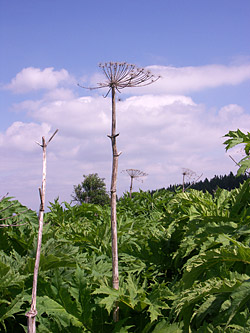
Giant hogweed
Foto: Petr Pysek/Institute of Botany
Academy of Sciences, Czech Republik
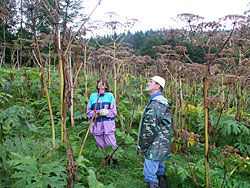
Height of a giant hogweed of up to 4 metres
Foto: Petr Pysek/Institute of Botany
Academy of Sciences, Czech Republik
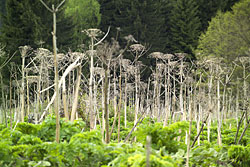
Colonies of giant hogweed in a former military zone near Marianske Lazne in the west of the Czech Republic near
the border with Bavaria
Foto: André Künzelmann/UFZ
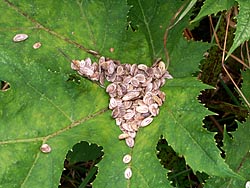
Just one plant produces around 20 000 seeds.
Foto: Petr Pysek/Institute of Botany
Academy of Sciences, Czech Republik
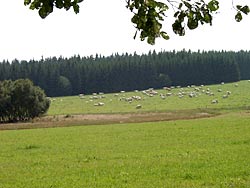
Agricultural land use or grazing as control measures against giant hogweed
Foto: Tilo Arnhold/UFZ
An aggressive newcomer
From a distance, the tall plants, which are up to four metres high, look impressive. But from close to, the giant hogweed (Latin name: Heracleum mantegazzianum) quickly loses its fascination. This is because the extremely aggressive sap inside the plant can cause third-degree burns. And the giant hogweed does not only represent a danger to humans – the plant world is also affected. The large leaves create so much shade that few other plants can grow on the ground. As a result, when the giant hogweed dies in the autumn, large areas remain bare and erosion takes place. The plant may no longer be handled in Britain, and other countries are also considering counter-strategies.
The plant originally comes from Caucasus. In the 19th century it was introduced to Central Europe as an ornamental plant. Since then the giant hogweed has been spreading here in Germany too.
Prediction models required
Nana Nehrbaß of the UFZ is investigating how this happens. The scientist is interested in the factors that favour or hinder the plant’s spread. “Linear structures like rivers and roads appear to be the main dispersal methods. The seeds are transported along them in the water or attached to the tyres of vehicles”, recounts Nana Nehrbaß. The giant hogweed was originally considered to be an ornamental plant or bee pasture. In areas of the former Soviet Union people even considered using the giant hogweed as a fodder crop, but it soon proved unsuitable.
On her computer the scientist analyses aerial photographs. The pale flowers are easy to recognise from the air. On the black and white photos, white dots represent flowering giant hogweed plants. Together with Czech colleagues she is using the photos to study the spread of the plant in a former military zone near Marianske Lazne in the west of the Czech Republic near the border with Bavaria. There are aerial photos of the Slavkovsky les (Slavkov Forest) area that document the development over the last 50 years. “The giant hogweed is comparable with prominent invading species all over the world”, says Petr Py¨ek of the Botanical Institute of the Academy of Sciences of the Czech Republic. “It has a remarkable invasion potential. On top of this, efficient reproduction makes it extremely difficult to control or eradicate this species.” Just one plant produces around 20 000 seeds.
Immigrant species cause terrible damage
The aim of the research is to produce computer models with which it will be possible to predict the spread of invading species. So far, all the dispersal simulations have been only in a rough grid of 25x25 or 10x10 kilometres and therefore very imprecise. Now it is possible to take into account local factors, like land use or roads, as well.
The German Federal Agency for Nature Conservation estimates the damage caused by introduced animal and plant species to be at least 100 million euros per year in Germany alone. With globalisation and global trade there is an increased risk that new plants – so-called neophytes – will spread here in Germany and unbalance the old ecosystems. This is why the European research project GIANT ALIEN was set up. Because effective strategies can be developed only if the dispersal routes are known and can be predicted.
Control measures are controversial
The fact that the giant hogweed can become a problem is beyond question. But how should it be controlled? In Germany there is no notification requirement and no uniform guideline. Whether something must be done, and what, depends on the local authorities or nature conservation associations. Radical solutions provide for mowing and digging out the roots – naturally only with protective clothing including gloves, eye and mouth protection. In her doctoral thesis, Nana Nehrbaß suggests a much simpler solution, which is already being implemented in Scandinavian countries: “A large proportion of the local dispersal potential is defined by fallow land. In areas where lots of meadows and fields cannot be used, the giant hogweed can spread easily. The best control measure is therefore agricultural land use or grazing” The scientists hope that they will be able to produce forecasts for other immigrant species in the future using the computer models.
Tilo Arnhold
Weitere Links:
Weitere fachliche Information über:
Nana Nehrbaß (DE & EN)
Department Ökosystemanalyse
Centre for Environmental Research Leipzig-Halle (UFZ)
www.ufz.de/index.php?de=3893
Petr Pysek (CZ & EN)
Department of Invasion Ecology
Institute of Botany / Academy of Sciences of the Czech Republic
Phone: +420 (2) 71015266
www.ibot.cas.cz/personal/pysek
or
Doris Böhme / Tilo Arnhold,
Public Relations of Helmholtz Centre for Environmental Research – UFZ
Phone: +49-341-235-2278
E-mail: presse@ufz.de
